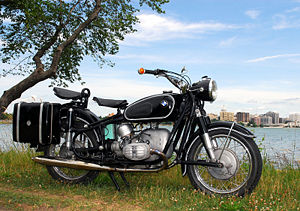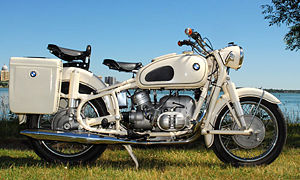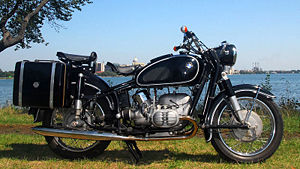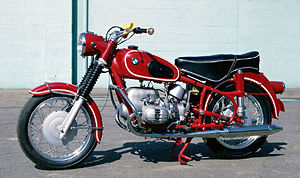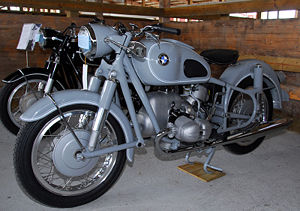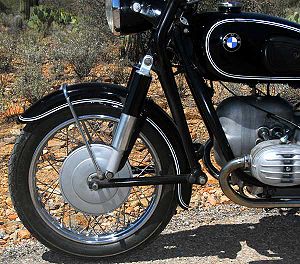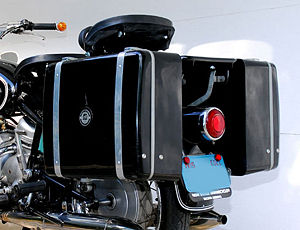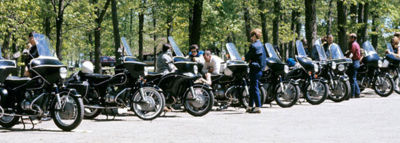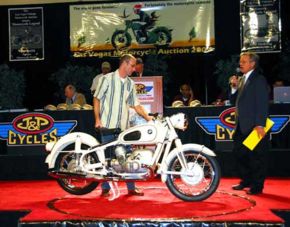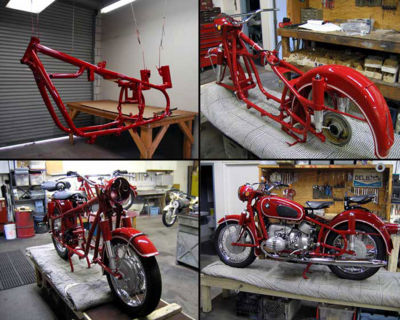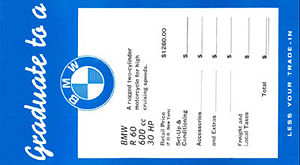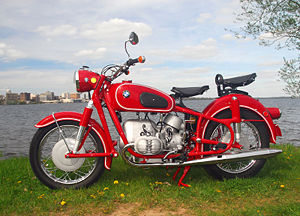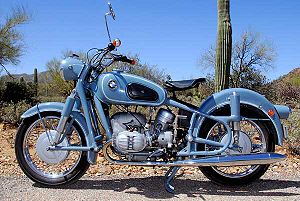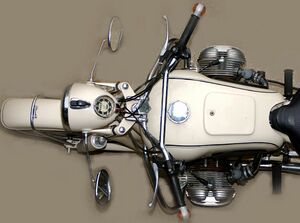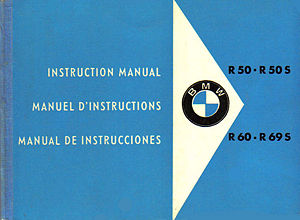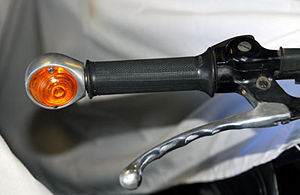BMW R60-2: Difference between revisions
imported>Jeffrey M. Dean No edit summary |
mNo edit summary |
||
| (26 intermediate revisions by 7 users not shown) | |||
| Line 1: | Line 1: | ||
{{subpages}} | |||
{{slashtitle|BMW R60/2}} | |||
[[Image:Weissband.jpg|thumb|400px|Granada red R60/2 • Dominican blue R50/2 • Standard black R60/2]] | [[Image:Weissband.jpg|thumb|400px|Granada red R60/2 • Dominican blue R50/2 • Standard black R60/2]] | ||
The '''R60''' and '''R60/2''' were 600cc | The '''R60''' and '''R60/2''' were 600cc boxer twin [[BMW Motorcycles|BMW motorcycles]] manufactured from 1956 to 1969 in [[Munich, Germany|Munich]], [[Germany]], by the ''Bayerische Motoren Werke'' (BMW Aktiengesellschaft). | ||
==Production | ==Production history== | ||
Some 20,133 of these 600cc shaft-drive, | Some 20,133 of these 600cc shaft-drive, opposed twin R60 (1956-1960, 28 hp), R60/2 (1960-1969, 30 hp), and R60US (1968-1969, 30 hp) were built. These models, except for those with the "US" designation, were designed primarily as rugged motorcycles to pull sidecars (mounting points were built in) and had duplex tubular steel frames. | ||
Simultaneously manufactured were related models, including the 500cc R50 (1955-1960, 26 hp), the R50/2 (1960-1969, 26 hp), the R50S (1960-1962, 35 hp), the R50US (1968-1969, 26 hp), and the 600cc sport-oriented R69 (1955-1960, 35 hp), R69S (1960-1969, 42 hp), and R69US (1968-1969, 42 hp). | Simultaneously manufactured were related models, including the 500cc R50 (1955-1960, 26 hp), the R50/2 (1960-1969, 26 hp), the R50S (1960-1962, 35 hp), the R50US (1968-1969, 26 hp), and the 600cc sport-oriented R69 (1955-1960, 35 hp), R69S (1960-1969, 42 hp), and R69US (1968-1969, 42 hp). | ||
| Line 11: | Line 13: | ||
Perhaps the most famous BMW rider of the 1960s was Danny Liska [http://www2.widener.edu/SBA/FacultyWebpages/Larson/adventure_page.htm], who took R60 models from Alaska to Tierra del Fuego in one trip, and from Europe's North Cape to South Africa's Cape of Good Hope in a second journey. His book about the first trip, ''Two Wheels to Adventure (Alaska to Argentina by Motorcycle)'', was published in 2004. | Perhaps the most famous BMW rider of the 1960s was Danny Liska [http://www2.widener.edu/SBA/FacultyWebpages/Larson/adventure_page.htm], who took R60 models from Alaska to Tierra del Fuego in one trip, and from Europe's North Cape to South Africa's Cape of Good Hope in a second journey. His book about the first trip, ''Two Wheels to Adventure (Alaska to Argentina by Motorcycle)'', was published in 2004. | ||
[[Image:R60-400.jpg|thumb|1968 BMW R60/2 in standard black with white pinstriping]] | [[Image:R60-400.jpg|thumb|1968 BMW R60/2 in standard black with white pinstriping]] | ||
[[Image:Weiss.jpg|thumb|left|1967 R60/2 in original Dover white paint]] | |||
The standard colors for these motorcycles was black with white pinstriping, though special colors could be ordered. Indeed, the motorcycles could be ordered in any color that was being used at the time for BMW cars. A special case was ''Dover white.'' Michael Bondy, of the U.S.A. BMW importer Butler & Smith, sent BMW a can of that color paint, which was used on his 1942 Packard, and BMW duplicated it. He then ordered 50 motorcycles in that color. | |||
Though BMW invented and first used oil-damped telescopic motorcycle front forks in the 1930s, it chose to use ''Earles'' forks on these models. The triangular front Earles fork (named after its designer, Englishman Ernest Earles) precluded any front-end dive during heavy front braking, which is common with telescopic front forks. It also worked well in sidecar duty. Though heavy and ponderous in turning, the Earles fork gave the old Beemer a steady and reassuring ride. | |||
[[Image:67r60-500.jpg|thumb|left|1967 BMW R60/2 with Denfeld saddles and 6½ gallon tank]] | |||
Though BMW invented and first used oil-damped telescopic | |||
[[Image:67r60-500.jpg|thumb|left|1967 BMW R60/2 with | |||
[[Image:68red-500.jpg|thumb|New, unsold 1968 BMW R60US with telescopic forks]] | [[Image:68red-500.jpg|thumb|New, unsold 1968 BMW R60US with telescopic forks]] | ||
[[Image:Gray-r60-2.jpg|thumb|An R69S in gray with white prinstriping]] | |||
[[Image:2-saddles.jpg|thumb|Individual Denfeld or Pagusa driver and passenger saddles were an alternative to the dual saddle]] | [[Image:2-saddles.jpg|thumb|Individual Denfeld or Pagusa driver and passenger saddles were an alternative to the dual saddle]] | ||
In 1968, BMW introduced telescopic forks on some of its slash-2 models, and they were continued into the 1969 model year. Modified, they became the front forks on the slash-5 models introduced for the 1970 model year. The photo of the red R60US to the right was taken at a BMW dealership in 1968 and shows a brand new motorcycle waiting for its first buyer. Earles fork and telescopic fork models both were manufactured for these two years and were available to customers. | In 1968, BMW introduced telescopic forks on some of its slash-2 models, and they were continued into the 1969 model year. Modified, they became the front forks on the slash-5 models introduced for the 1970 model year. The photo of the red R60US to the right was taken at a BMW dealership in 1968 and shows a brand new motorcycle waiting for its first buyer. Earles fork and telescopic fork models both were manufactured for these two years and were available to customers. | ||
During the 1960s, very few motorcycles were available with shaft final drive. BMW's were the most common. The | During the 1960s, very few motorcycles were available with shaft final drive. BMW's were the most common. The driveshaft rode in an enclosed oil bath within the right swingarm, unlike BMW's previous models, and drove the rear wheel through an internally splined cup that meshes with a coupler crown gear keyed to the drive pinion. This meant that leaking seals could a problem for the owners. Because the clutch was dry, there were seals at the rear of the crankshaft, at both ends of the transmission, at the rear of the driveshaft, and at the front and rear of the rear drive unit: lots of seals to develop leaks. | ||
The front brakes were double leading shoes, and the rear had a single leading shoe. By modern standards, they were not good brakes. Tires, front and rear, were interchangeable in 3.50" by 18" size. | The front brakes were double leading shoes, and the rear had a single leading shoe. By modern standards, they were not good brakes. Tires, front and rear, were interchangeable in 3.50" by 18" size. | ||
[[Image:Bmw-earles.jpg|thumb|left|The triangulated Earles front fork]] | |||
Motorcycles sold in America had high | Motorcycles sold in America had high handlebars with a cross brace. Those sold elsewhere came with low, ''Euro'' handlebars. | ||
A variety of saddle styles were available for these motorcycles. Those delivered in the U. S. typically were supplied with a single "dual" or bench saddle, either the standard size or a wide version that came with chrome rear-quarter passenger handles. Alternatives available included a Denfeld (''not'' "Denfield") or Pagusa solo driver's saddle, or individual driver and passenger saddles. | A variety of saddle styles were available for these motorcycles. Those delivered in the U. S. typically were supplied with a single "dual" or bench saddle, either the standard size or a wide version that came with chrome rear-quarter passenger handles. Alternatives available included a Denfeld (''not'' "Denfield") or Pagusa solo driver's saddle, or individual driver and passenger saddles. | ||
====Earles fork==== | ====Earles fork==== | ||
The Earles fork deserves special mention because of its association with this period in BMW motorcycle evolution. It was a variety of leading link fork where the pivot point was aft of the rear of the wheel — this was the basis of the Earles's patent. Designed by Englishman Ernest Earles, this triangulated fork actually caused the front end of a motorcycle to rise when braking hard — the reverse of the action of a telescopic fork, which plunges downward in front when braking. It was designed to accommodate sidecars, though from 1955 to 1969, BMW used the fork even though most of its motorcycles were sold as solo bikes. | |||
==Accessories== | ==Accessories== | ||
[[Image:Golden-arrows-small.jpg|thumb|Craven's Golden Arrow saddlebags]] | |||
[[Image:R60-avon.jpg|thumb|R60/2 with Avon full fairing and Craven top case]] | [[Image:R60-avon.jpg|thumb|R60/2 with Avon full fairing and Craven top case]] | ||
BMW motorcycles of the 1960s were noted as long-distance | BMW motorcycles of the 1960s were noted as long-distance touring motorcycles. However, none came standard with fairings or luggage, these items were provided by aftermarket vendors. | ||
Most common as a fairing then was the Wixom Ranger handlebar-mounted fairing made in Illinois, which was mounted on most of the BMW twins sold. A rare full fairing from England was made by Avon (see photo). | Most common as a fairing then was the Wixom Ranger handlebar-mounted fairing made in Illinois, which was mounted on most of the BMW twins sold. A rare full fairing from England was made by Avon (see photo). | ||
There were numerous manufacturers of saddle bags and top cases for BMW twins in the 1960s. Wixom's were very popular, as were the beautifully made but boxy British Craven ''panniers (see external links below)''. Rounded ''Enduro'' [http://thecreeper.net/r50/] bags ''(see the external link below for an reproductions)'' were very popular as well. Butler and Smith, the American BMW motorcycle importer, offered leather saddlebags. | There were numerous manufacturers of saddle bags and top cases for BMW twins in the 1960s. Wixom's were very popular, as were the beautifully made but boxy British Craven ''panniers (see external links below)''. Rounded ''Enduro'' [http://thecreeper.net/r50/] bags ''(see the external link below for an reproductions)'' were very popular as well. Butler and Smith, the American BMW motorcycle importer, offered leather saddlebags. | ||
{{Image|Madclub-600.jpg|left|400px|The Madison (WI) BMW club in 1970, with lots of Wixom fairings.}} | |||
Butler and Smith offered several styles of luggage carriers for mounting behinds the passenger saddle. It also offered several styles of windshields, safety bars, a spotlight, and metric tool kits. One expensive and highly sought after accessory was a mechanical tachometer. | Butler and Smith offered several styles of luggage carriers for mounting behinds the passenger saddle. It also offered several styles of windshields, safety bars, a spotlight, and metric tool kits. One expensive and highly sought after accessory was a mechanical tachometer. | ||
| Line 48: | Line 51: | ||
The standard fuel tank held 4½ gallons, though a commonly purchased option was a more bulbous 6½ gallon tank. Also available as options were sport tanks of 7.0 and 8.0 gallons capacities. | The standard fuel tank held 4½ gallons, though a commonly purchased option was a more bulbous 6½ gallon tank. Also available as options were sport tanks of 7.0 and 8.0 gallons capacities. | ||
==Restoration== | ==Restoration== | ||
{{Image|LV-Auction.jpg|left|290px|A restored R50/2 at auction in Las Vegas}} | |||
[[Image:Restore600.jpg|thumb|400px|An R60/2 undergoing a frame-up concours restoration]] | [[Image:Restore600.jpg|thumb|400px|An R60/2 undergoing a frame-up concours restoration]] | ||
Admirers of classic BMW motorcycles are growing rapidly in number. As time marches on, that which BMW enthusiasts consider "classic" is amended, much as a trailer follows behind a car. "Slash-2" variants from 1955-1969 have joined that exclusive club. | Admirers of classic BMW motorcycles are growing rapidly in number. As time marches on, that which BMW enthusiasts consider "classic" is amended, much as a trailer follows behind a car. "Slash-2" variants from 1955-1969 have joined that exclusive club. | ||
| Line 58: | Line 60: | ||
Two American membership organizations, Vintage BMW Motorcycle Owners and the Veteran BMW Motorcycle Club of America are dedicated to the preservation of classic BMW motorcycles. | Two American membership organizations, Vintage BMW Motorcycle Owners and the Veteran BMW Motorcycle Club of America are dedicated to the preservation of classic BMW motorcycles. | ||
==Original prices for an R60/2== | ==Original prices for an R60/2== | ||
| Line 69: | Line 69: | ||
==Specifications== | ==Specifications== | ||
[[Image:400-w.jpg|thumb|1969 BMW R60/2 in Granada red]] | [[Image:400-w.jpg|thumb|1969 BMW R60/2 in Granada red]] | ||
[[Image:Weiss0.jpg|thumb|1967 BMW R60/2 in original Dover white and 6½ gallon tank]] | [[Image:Weiss0.jpg|thumb|1967 BMW R60/2 in original Dover white and 6½ gallon tank and Craven saddlebags]] | ||
[[Image:Gray-r60-2.jpg|thumb|BMW R60/2 in original gray paint]] | |||
[[Image:Gray-small.jpg|thumb|1968 BMW R50/2 in original Dominican blue]] | [[Image:Gray-small.jpg|thumb|1968 BMW R50/2 in original Dominican blue]] | ||
[[Image:Opposed-cylinders.jpg|thumb|R60/2 opposed cylinders seen from above]] | [[Image:Opposed-cylinders.jpg|thumb|R60/2 opposed cylinders seen from above]] | ||
| Line 87: | Line 87: | ||
* Internal designation 267 / 5 | * Internal designation 267 / 5 | ||
* Type | * Type four-stroke, two-cylinder, air-cooled boxer | ||
* Bore/stroke 72 x 73 mm | * Bore/stroke 72 x 73 mm | ||
* Cubic capacity 594 cm3 (34 in.3) | * Cubic capacity 594 cm3 (34 in.3) | ||
| Line 125: | Line 125: | ||
'''Dimensions and Weights''' | '''Dimensions and Weights''' | ||
[[Image:Owners-manual-cover.jpg|thumb|The 1964 owner's manual came in three languages]] | |||
* Length x width x height 84 x 26 x 39 inches (2125 x 660 x 980 mm) | * Length x width x height 84 x 26 x 39 inches (2125 x 660 x 980 mm) | ||
| Line 133: | Line 135: | ||
'''Performance''' | '''Performance''' | ||
[[Image:Bar-end-signal.jpg|thumb|Hella's bar-end turn signal]] | |||
* Idle/riding noise 81/82 DIN-phon (from June 1967: 74 / 95 dB (A)) | * Idle/riding noise 81/82 DIN-phon (from June 1967: 74 / 95 dB (A)) | ||
| Line 139: | Line 143: | ||
* Top speed 90 MPH (145 km/h) | * Top speed 90 MPH (145 km/h) | ||
<!--[[Image:Vcover-2.jpg|thumb|R60/2 six-fin valve cover-->[[Category:Suggestion Bot Tag]] | |||
<!--[[Image:Vcover-2.jpg|thumb|R60/2 six-fin valve cover | |||
[[Category: | |||
Latest revision as of 12:00, 15 July 2024
The R60 and R60/2 were 600cc boxer twin BMW motorcycles manufactured from 1956 to 1969 in Munich, Germany, by the Bayerische Motoren Werke (BMW Aktiengesellschaft).
Production history
Some 20,133 of these 600cc shaft-drive, opposed twin R60 (1956-1960, 28 hp), R60/2 (1960-1969, 30 hp), and R60US (1968-1969, 30 hp) were built. These models, except for those with the "US" designation, were designed primarily as rugged motorcycles to pull sidecars (mounting points were built in) and had duplex tubular steel frames.
Simultaneously manufactured were related models, including the 500cc R50 (1955-1960, 26 hp), the R50/2 (1960-1969, 26 hp), the R50S (1960-1962, 35 hp), the R50US (1968-1969, 26 hp), and the 600cc sport-oriented R69 (1955-1960, 35 hp), R69S (1960-1969, 42 hp), and R69US (1968-1969, 42 hp).
In the United States, all these Earles-fork (see below) and US-fork (i.e., telescopic fork) models from 1955 to 1969 are often lumped together as "Slash-2" BMWs, even though that is technically incorrect. Not all over them, as seen above, have the "/2" designation.
Perhaps the most famous BMW rider of the 1960s was Danny Liska [1], who took R60 models from Alaska to Tierra del Fuego in one trip, and from Europe's North Cape to South Africa's Cape of Good Hope in a second journey. His book about the first trip, Two Wheels to Adventure (Alaska to Argentina by Motorcycle), was published in 2004.
The standard colors for these motorcycles was black with white pinstriping, though special colors could be ordered. Indeed, the motorcycles could be ordered in any color that was being used at the time for BMW cars. A special case was Dover white. Michael Bondy, of the U.S.A. BMW importer Butler & Smith, sent BMW a can of that color paint, which was used on his 1942 Packard, and BMW duplicated it. He then ordered 50 motorcycles in that color.
Though BMW invented and first used oil-damped telescopic motorcycle front forks in the 1930s, it chose to use Earles forks on these models. The triangular front Earles fork (named after its designer, Englishman Ernest Earles) precluded any front-end dive during heavy front braking, which is common with telescopic front forks. It also worked well in sidecar duty. Though heavy and ponderous in turning, the Earles fork gave the old Beemer a steady and reassuring ride.
In 1968, BMW introduced telescopic forks on some of its slash-2 models, and they were continued into the 1969 model year. Modified, they became the front forks on the slash-5 models introduced for the 1970 model year. The photo of the red R60US to the right was taken at a BMW dealership in 1968 and shows a brand new motorcycle waiting for its first buyer. Earles fork and telescopic fork models both were manufactured for these two years and were available to customers.
During the 1960s, very few motorcycles were available with shaft final drive. BMW's were the most common. The driveshaft rode in an enclosed oil bath within the right swingarm, unlike BMW's previous models, and drove the rear wheel through an internally splined cup that meshes with a coupler crown gear keyed to the drive pinion. This meant that leaking seals could a problem for the owners. Because the clutch was dry, there were seals at the rear of the crankshaft, at both ends of the transmission, at the rear of the driveshaft, and at the front and rear of the rear drive unit: lots of seals to develop leaks.
The front brakes were double leading shoes, and the rear had a single leading shoe. By modern standards, they were not good brakes. Tires, front and rear, were interchangeable in 3.50" by 18" size.
Motorcycles sold in America had high handlebars with a cross brace. Those sold elsewhere came with low, Euro handlebars.
A variety of saddle styles were available for these motorcycles. Those delivered in the U. S. typically were supplied with a single "dual" or bench saddle, either the standard size or a wide version that came with chrome rear-quarter passenger handles. Alternatives available included a Denfeld (not "Denfield") or Pagusa solo driver's saddle, or individual driver and passenger saddles.
Earles fork
The Earles fork deserves special mention because of its association with this period in BMW motorcycle evolution. It was a variety of leading link fork where the pivot point was aft of the rear of the wheel — this was the basis of the Earles's patent. Designed by Englishman Ernest Earles, this triangulated fork actually caused the front end of a motorcycle to rise when braking hard — the reverse of the action of a telescopic fork, which plunges downward in front when braking. It was designed to accommodate sidecars, though from 1955 to 1969, BMW used the fork even though most of its motorcycles were sold as solo bikes.
Accessories
BMW motorcycles of the 1960s were noted as long-distance touring motorcycles. However, none came standard with fairings or luggage, these items were provided by aftermarket vendors.
Most common as a fairing then was the Wixom Ranger handlebar-mounted fairing made in Illinois, which was mounted on most of the BMW twins sold. A rare full fairing from England was made by Avon (see photo).
There were numerous manufacturers of saddle bags and top cases for BMW twins in the 1960s. Wixom's were very popular, as were the beautifully made but boxy British Craven panniers (see external links below). Rounded Enduro [2] bags (see the external link below for an reproductions) were very popular as well. Butler and Smith, the American BMW motorcycle importer, offered leather saddlebags.
Butler and Smith offered several styles of luggage carriers for mounting behinds the passenger saddle. It also offered several styles of windshields, safety bars, a spotlight, and metric tool kits. One expensive and highly sought after accessory was a mechanical tachometer.
U.S. motorcycles came standard with a narrow dual saddle, though wide dual saddles with chrome rear handles could be ordered. Solo saddles made by Pagusa or Denfeld for driver and passenger were also available. All motorcycles came with BMW's famously complete tool kit.
Hella turn signals were strictly optional, and were mounted at the ends of the handlebars showing light both forward and back.
The standard fuel tank held 4½ gallons, though a commonly purchased option was a more bulbous 6½ gallon tank. Also available as options were sport tanks of 7.0 and 8.0 gallons capacities.
Restoration
Admirers of classic BMW motorcycles are growing rapidly in number. As time marches on, that which BMW enthusiasts consider "classic" is amended, much as a trailer follows behind a car. "Slash-2" variants from 1955-1969 have joined that exclusive club.
Opinions as to the treatment of classic motorcycle varies according to their condition and their owners' tastes. First preference tends to be for preserving the original machine if it is in reasonably good condition. Second preference is to do limited restoration, maintaining as much of the original fabric as possible. Third, when dealing with a machine in poor condition, is so-called frame-up restoration. In the latter case, the motorcycle is completely disassembled and each individual part is refurbished, and then the motorcycle is reassembled adhering as much as possible to the original design, but sometimes using modern replacement parts, such as stainless steel, or plating parts that were originally not plated. At the extreme end of restoration is the "concours" restoration, as seen in the photo to the right, in which only original parts are used and work is done with an obsession for originality in every minor detail. Unlike many other motorcycle brands, parts for classic BMWs, though expensive, are obtainable from sources in Germany and the United States.
Two American membership organizations, Vintage BMW Motorcycle Owners and the Veteran BMW Motorcycle Club of America are dedicated to the preservation of classic BMW motorcycles.
Original prices for an R60/2
- U.S. Price: $1,131.- (1960)
- U.S. Price: $1,236.- (1965)
- U.S. Price: $1,364.- (1969) ($7,526 in 2006 when adjusted for inflation)
- German Price: DM 3,315.-
Specifications
Engine Numbers
- 1955-1960 R50 Engine Numbers: 550 001 - 563 515
- 1960-1969 R50/2 & R50US Engine Numbers: 630 001 - 649 037
- 1956-1960 R60 Engine Numbers: 618 001 — 621 530
- 1960-1966 R60/2 Engine Numbers: 622 001 — 629 999
- 1966-1969 R60/2 & R60US Engine Numbers: 1 810 001 — 1 819 307
- 1956-1960 R69 Engine Numbers: 652 001 — 654 955
- 1960-1969 R69S & R69US Engine Numbers: 655 004 — 666 320
Engine
- Internal designation 267 / 5
- Type four-stroke, two-cylinder, air-cooled boxer
- Bore/stroke 72 x 73 mm
- Cubic capacity 594 cm3 (34 in.3)
- Maximum power 30 HP at 5800 RPM
- Compression ratio 7.5 : 1
- Valves per cylinder ohv
- Carburation system 2 Bing 1/24/125-126 od. 1/24/133-134 od. 1/24/151-152
- Engine lubrication forced-feed lubrication
- Oil pump gear pump
Power Transmission
- Clutch single disc saucer spring, dry
- Number of gears 4
- Shifting foot shifting
- Gear ratios 4.7 / 2.73 / 1.94 / 1.54 (with sidecar: 5.33 / 3.02 / 2.04 / 1.54)
- Rear wheel ratio 1 : 3.13 or 1:3.38 (with sidecar 1 : 3.86)
- Bevel/crown wheel 18 / 27 or 8 / 25 teeth (with sidecar 7 / 27)
Electrical System
- Alternator Bosch LJ/CGE 60/6/1700 R
- Ignition magneto ignition
- Spark plugs Bosch W 240 T 1 or Beru 240 / 14
Suspension
- Designation 245/1
- Type of frame twin-loop steel tubular frame
- Front suspension long swinging arm with strut and oil-pressure shock absorbers
- Rear suspension long swinging arm with strut and oil-pressure shock absorbers
- Wheel rims deep-bed 2.15 B x 18 at sidecar, rear 2.75C x 18
- Tires front 3.50 x 18
- Tires rear 3.50 x 18 ( at sidecarbetrieb hinten 4 x 18)
- Brakes front drum brake, Ø 200 mm Duplex full hub
- Brakes rear drum brake, Ø 200 mm Simplex full hub
Dimensions and Weights
- Length x width x height 84 x 26 x 39 inches (2125 x 660 x 980 mm)
- Wheel base 55.7 inches (1415 mm; with sidecar 1450 mm)
- Tank capacity 4½ gals. (17 l) / optional 6½ gals. (24.6 l)
- Unladen weight, full tank 430 lbs. (195 kg; with orig. BMW sidecar 320 kg)
- Load rating 360 kg (with orig. BMW sidecar 600 kg)
Performance
- Idle/riding noise 81/82 DIN-phon (from June 1967: 74 / 95 dB (A))
- Fuel consumption 47.0 MPG (ca. 5.0 l / 100 km)
- Oil consumption ca. 0.5 - 1 l / 1000 km
- Top speed 90 MPH (145 km/h)

